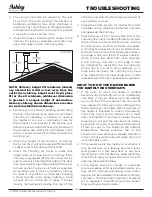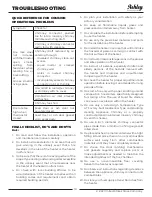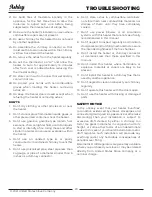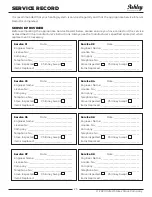
© 2021 United States Stove Company
15
reduced by proper setting of the air shutter on the
ash door. Rotating the air shutter to allow more
air into the fire chamber will increase the rate of
the minimum fire and reduce the accumulation.
Experience in a particular heating situation
will give guidance in choosing the best setting.
Setting changes are made with common pliers.
Set the shutter to the largest opening and use a
smaller opening only if the heat output cannot be
adequately controlled by the thermostat.
COAL FACTS
Anthracite coal (known as hard coal) is the only
coal with a uniform sizing scale. Before leaving the
coal mine, it is graded into one to the following
categories:
• Nut - from 13/16” to 1-5/8” in diameter.
• Stove - from 1-5/8” to 2-7/16” in diameter.
• Egg - from 2-7/16” to 3-1/4” in diameter.
• Broken - more than 3-1/4” in diameter.
Anthracite coal is hard to ignite; but once it is
burning, it burns freely and cleanly and very hot.
It does not fuse but leaves substantial ash residue.
When anthracite burns with a blue flame, it is
burning properly and the volatile gases released
from the coal are being consumed by the fire.
Bituminous coal is easier to ignite than anthracite
coal. Most people think anthracite has a higher
heat content than bituminous, but in actuality,
some bituminous is as good as anthracite.
Bituminous breaks up more in storage and burns
with more smoke than does anthracite. One other
characteristic of bituminous which differentiates it
from anthracite is that, as the coal burns, it tends
to form clinkers whereas anthracite is reduced
mainly to ash. Clinkers are the misshapen, rough,
gray lumps that form when particles in the coal are
heated, melt and fuse together. When bituminous
burns with a yellow flame, it is burning properly and
the volatile gases being released from the coal are
being consumed by the fire. Of these two coals,
anthracite is the more expensive. Store in a dry,
ventilated space.
Coal that is improperly stored can catch fire from
heat generated by chemical changes occurring
within the coal bed (spontaneous combustion). To
avoid the development of these conditions, coal
quantities that will be stored more than three days
should be kept clean of all combustible materials,
such as leaves, hay, wood, rags, etc., and stored
where the temperature of the air and objects the
coal contacts are 75 degrees F. or less. Alternate
wetting and drying of coal should be avoided. Wet
and dry coal should never be stored where each
will be in contact with the other. If the emission of
heat or unusual odors from a coal storage area is
observed, the process leading up to spontaneous
combustion may be occurring and the fire
department should be called immediately. Small
quantities of coal required for fire tending must be
kept at least 36” from the heater.
OPERATION
Содержание BCAC
Страница 21: ... 2021 United States Stove Company 21 PARTS DIAGRAM ...
Страница 24: ...24 2021 United States Stove Company NOTES ...
























